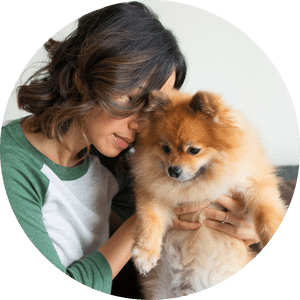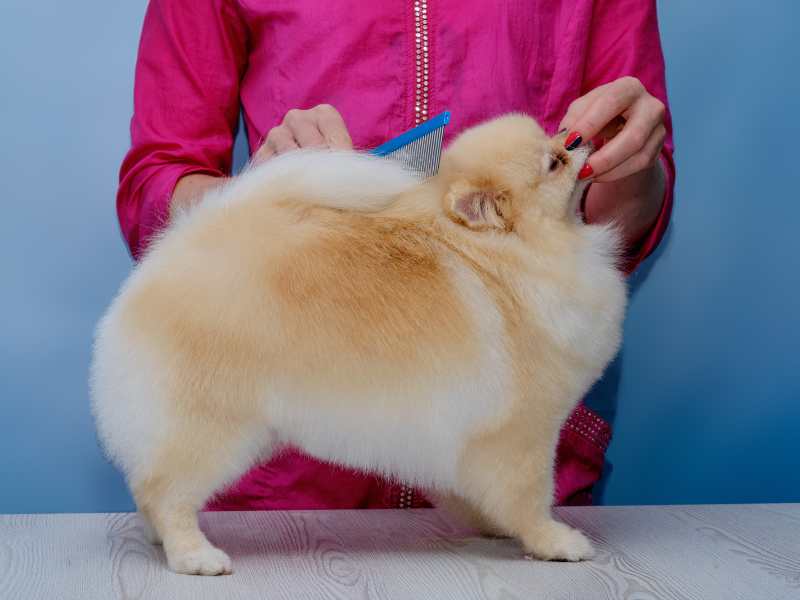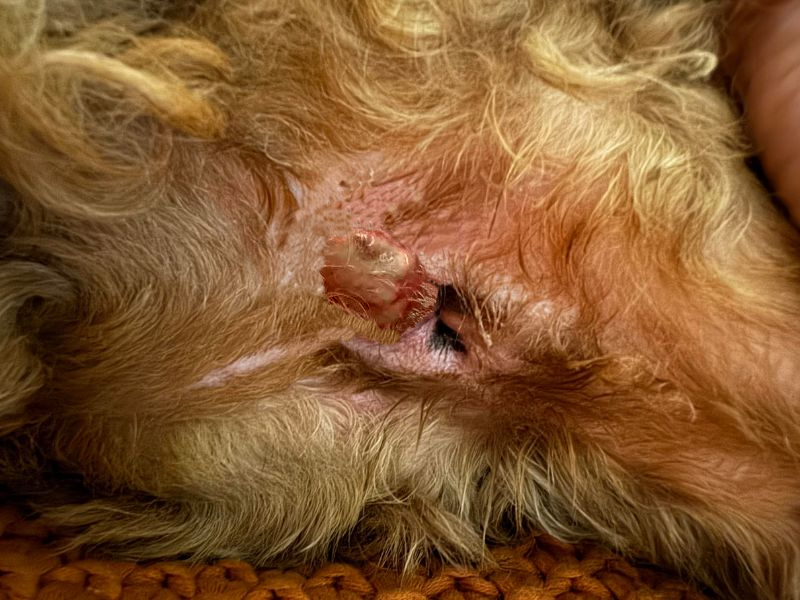
Has your dog suddenly developed a large, red lump near its bottom? Is the swelling growing alarmingly fast, appearing to be a pus-filled abscess?
If your pomeranian is in pain or exhibits signs of extreme discomfort with its backside, you might be facing an anal gland issue.
Let me share the experience we had with our Pomeranian when she experienced the abrupt onset of an anal gland rupture, including photos documenting the timeline and the subsequent healing process.

Dogs are prone to anal sac issues, which demand prompt medical intervention should an abscess form and burst. Neglecting treatment can result in swift infection spread, causing considerable harm to the anus and rectum.
Given the abundance of advice circulating regarding anal gland problems, it’s easy to feel overwhelmed and confused.
We’ll recount our personal journey dealing with a scenario of anal gland rupture with our Pomeranian, shedding light on what we wish we had understood earlier!
Health Advisory: The following contains graphic images depicting our dog’s anal gland abscess and rupture, which may unsettle some readers!
What Exactly Are Anal Glands?
Many are unaware that dogs possess two glands near their anus, known as anal sacs or anal glands, situated beneath the skin close to where the rectum meets the anus.
These glands generate a stinky fluid typically expelled from your dog’s body during pooping, yet occasionally, these secretions accumulate internally, necessitating manual expression by a veterinarian.
A significant portion of dogs will encounter some form of complication with their anal glands throughout their lives.
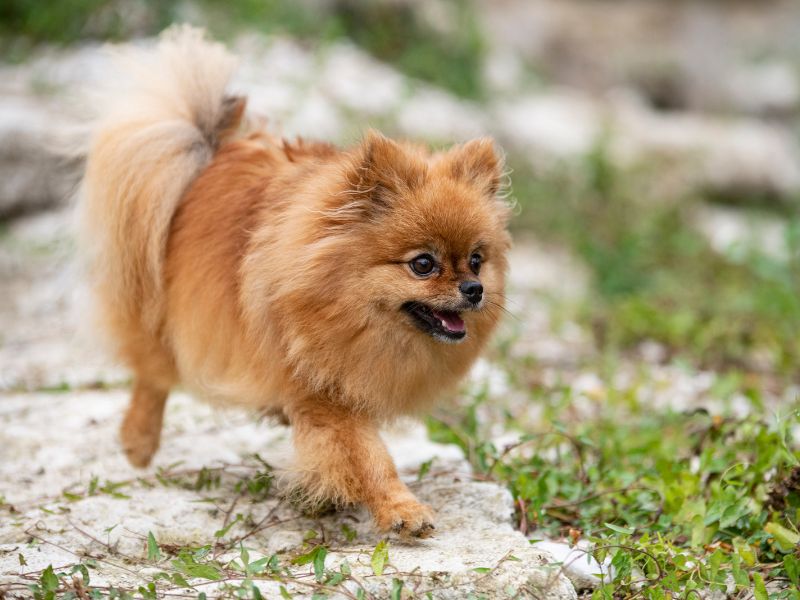
List of Symptoms of an Anal Gland Abscess in Dogs
- Red, swollen bottom
- Scooting (dragging their bottom along the ground)
- Signs of pain during pooping
- Sudden attempts to reach around and lick their bottom
- Excessive licking
- Increased frequency of pooping or straining
- Foul, fishy smell
- The presence of a wound near their anus
- Sudden sitting down
- Discharge, or blood around their bottom
- Decreased energy levels
- Increased water consumption
- Loss of appetite
- Behavioral changes like whining or seeking close proximity to you
Confirmation of an issue doesn’t necessarily require the presence of all these symptoms.
Take for instance the infamous foul, fishy smell associated with anal gland secretion, which may not always be apparent.
When our dog began experiencing problems, we initially focused on detecting this scent, only to find it absent. This led us down a confusing path, mistakenly believing her anal glands couldn’t be the source of trouble!
Hence, seeking prompt professional guidance from a vet is crucial in such situations.
Let's delve into the timeline of our dog's journey with an anal gland abscess and subsequent rupture
On Day 1

We observed our Pomeranian scooting around the floor more frequently than usual. While she occasionally engages in this behavior, it was notably persistent that morning.
Upon inspection, her backside appeared normal with no sign of abnormalities.
As the day progressed, she exhibited increased water consumption, nearly double her typical intake, and sought more attention from us.
Additionally, she displayed sudden bouts of sitting and reaching towards her rear end.
Towards bedtime, we noticed a slight swelling on the left side of her anus. Despite moving gingerly and displaying caution when jumping onto the couch, she otherwise seemed fine.
Initially, we speculated that she may have been stung by an insect while spending time in the yard.
On Day 2
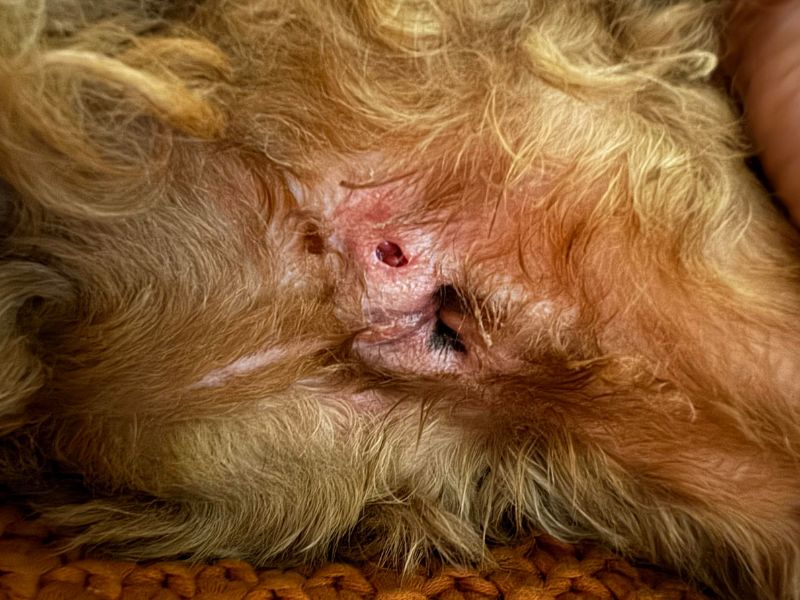
The following morning was quite alarming, to say the least.
We were taken aback by the rapid growth of the swelling overnight. What was initially almost non-existent had transformed into a significant, prominent abscess.
Our dog was clearly uncomfortable, and understandably so, as she repeatedly reached around to her rear end trying to discern what was happening.
Immediately, we contacted the vets, who scheduled us for an appointment that afternoon.
Despite being a Pomeranian known for her hearty appetite, she didn’t show any signs of loss of appetite and continued eating as usual. However, she was visibly struggling to poop, constantly in and out, attempting desperately to relieve herself but encountering difficulties.
Shortly after breakfast, while inside the house, she abruptly sat down, causing the abscess to burst!
This resulted in a small puddle of blood on the floor, which understandably startled us, although she appeared to feel much better afterward. Strangely, there was no foul smell accompanying the burst.
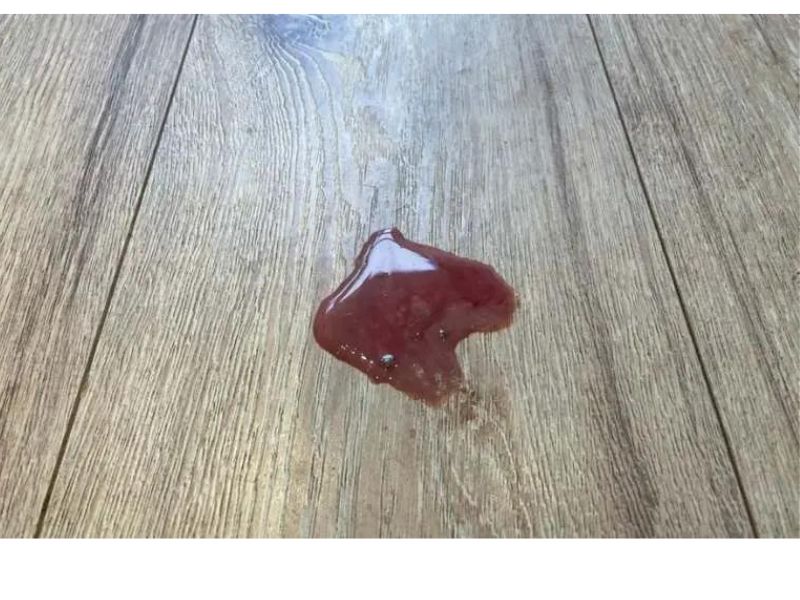
Following our trip to the veterinary clinic, they diagnosed our dog with an anal gland abscess and rupture. The vet prescribed a 10-day course of antibiotics, anti-inflammatories, and pain relief, with no additional treatment deemed necessary.
They cautioned us that the wound would worsen before beginning to heal, offering some reassurance amidst the challenges we were about to face.
On Day 3
By day 3, our dog showed significant improvement, managing to urinate and poop much more comfortably than in the previous days.
However, she couldn’t resist the urge to lick her backside, so we opted to place an Inflatable Collar on her, which she adapted to quite easily.
Additionally, we found ourselves frequently replacing blankets and towels on her bedding as the wound continued to seep.
Despite our efforts, she still persisted in scooting along the floor, inadvertently aggravating the wound and abscess. To our dismay, this led to the following unsettling discovery…
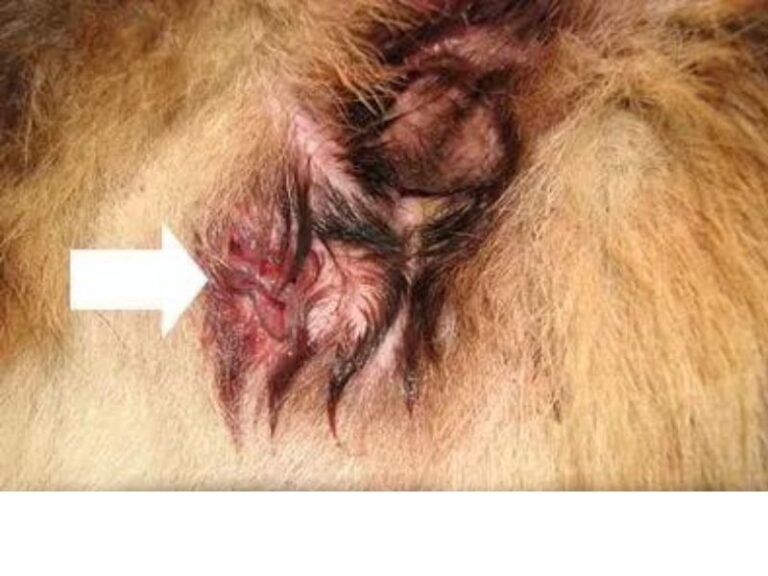
For those who have never encountered such an ordeal, it’s understandable how dog parents might react upon witnessing their beloved pets going through this.
Witnessing the rupture was truly heartbreaking, as it appeared excruciatingly painful. Surprisingly, however, our dog didn’t seem to be in any discomfort and was actually faring better than before.
Naturally, one might assume that such a sizable wound would require stitches to heal.
Yet, a brief video consultation with the vets offered reassurance that this was part of the expected process, and that the prescribed medication and anti-inflammatories would aid in the healing of the rupture.
What a relief!
On Days 4-14
In the days that followed, our pup gradually returned to her usual playful demeanor, though the sight of her rupture still made us cringe whenever she moved.
We attribute much of her comfort and the healing progress to the prescribed medication.
By around day 10, the rupture had fully healed. However, our dog found the scab somewhat bothersome and would frequently rub her bottom along the floor.
We kept a close eye on her, especially outdoors where the rough flooring posed a risk of reopening the wound.
Treating an Anal Gland Rupture in Dogs
1. Avoid Expressing Their Glands
2. Remain Calm
3. Seek Comfort
4. Seek Professional Assistance
5. Maintain Cleanliness
6. Prevent Licking
7. Use an Inflatable Collar
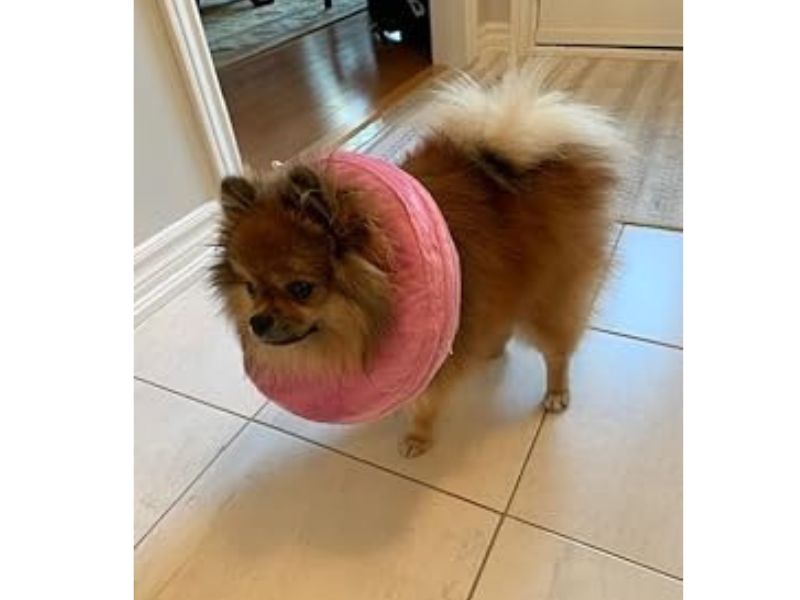
The Healing Process of Anal Gland Abscess and Rupture
The majority of anal gland abscesses and ruptures typically heal within 10-14 days, provided there are no complications.
It’s advisable to discourage your dog from scooting along the floor after the abscess has burst, as this could potentially aggravate the wound, leading to delays in the healing process.
As we’ve observed firsthand, the wound may initially appear more severe before showing signs of improvement. We were pleasantly surprised by how rapidly an anal gland rupture can heal!
Here’s a chronological overview (illustrated with photos) of the healing journey:
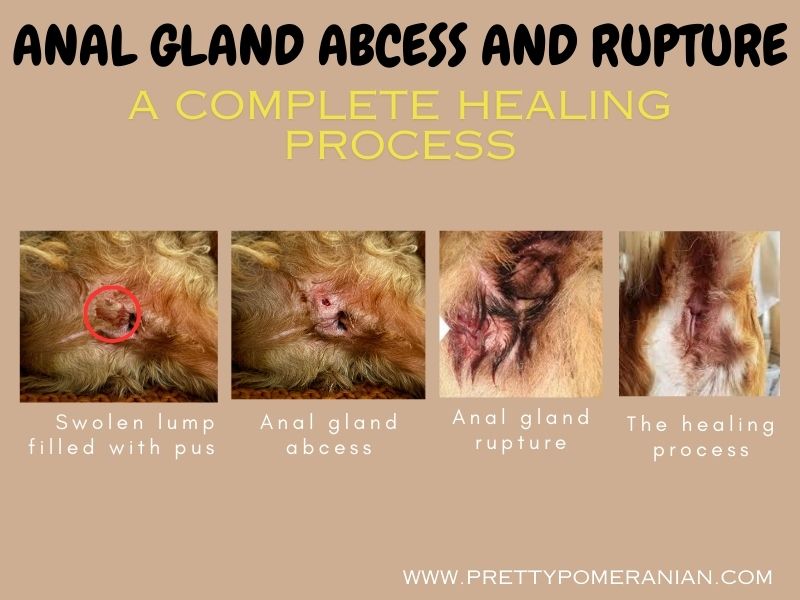
3 Methods to Help Prevent Anal Gland Abscess and Rupture in Dogs
1. Maintain Their Fitness Levels
2. Provide a Nutritious Diet
3. Schedule Regular Vet Visits
Is It Possible to Empty Anal Glands By Yourself?
In an ideal scenario, anal glands should be expressed by a veterinarian or a trained individual. Attempting to empty anal glands without proper training or when unnecessary can cause inflammation or worsen existing issues in otherwise healthy dogs. Moreover, some dogs may become dependent on manual expression and stop emptying their glands naturally.
If your dog experiences recurring issues, you can ask your vet to demonstrate what signs to watch for before scheduling an appointment.
What is The Cost of Treating Anal Gland Rupture in Dogs?
Once an anal gland has ruptured, there’s limited veterinary intervention available aside from flushing it out. Typically, a regimen of anti-inflammatories, pain relief, and/or antibiotics is prescribed for approximately 10 days. The average cost for a veterinary consultation including these medications falls around $180 / £140.
However, if the rupture remains untreated or complications arise, surgical intervention might be necessary to remove the anal glands. It’s essential to discuss these options thoroughly with your vet.
Emergency Veterinary Assistance
In situations where you’re unable to contact your regular veterinarian and require urgent advice regarding an anal gland tear or rupture, there are licensed vets available around the clock to provide guidance.
Furthermore, having appropriate insurance coverage can help alleviate concerns about covering any unforeseen associated expenses.
Rest assured, The Anal Gland Rupture of Your Dog Will Heal
If you’ve never encountered an anal gland rupture in your dog, consider yourself and your dog fortunate!
While these issues can be relatively common, discovering them may leave you feeling helpless as a pet owner. In most cases, there isn’t much that can be done to prevent them. Simply ensure to give your pup the extra love and attention they truly deserve.
We wish your dog all the best, and hope this article has provided reassurance that your dog will soon be back to their usual cheerful self!

